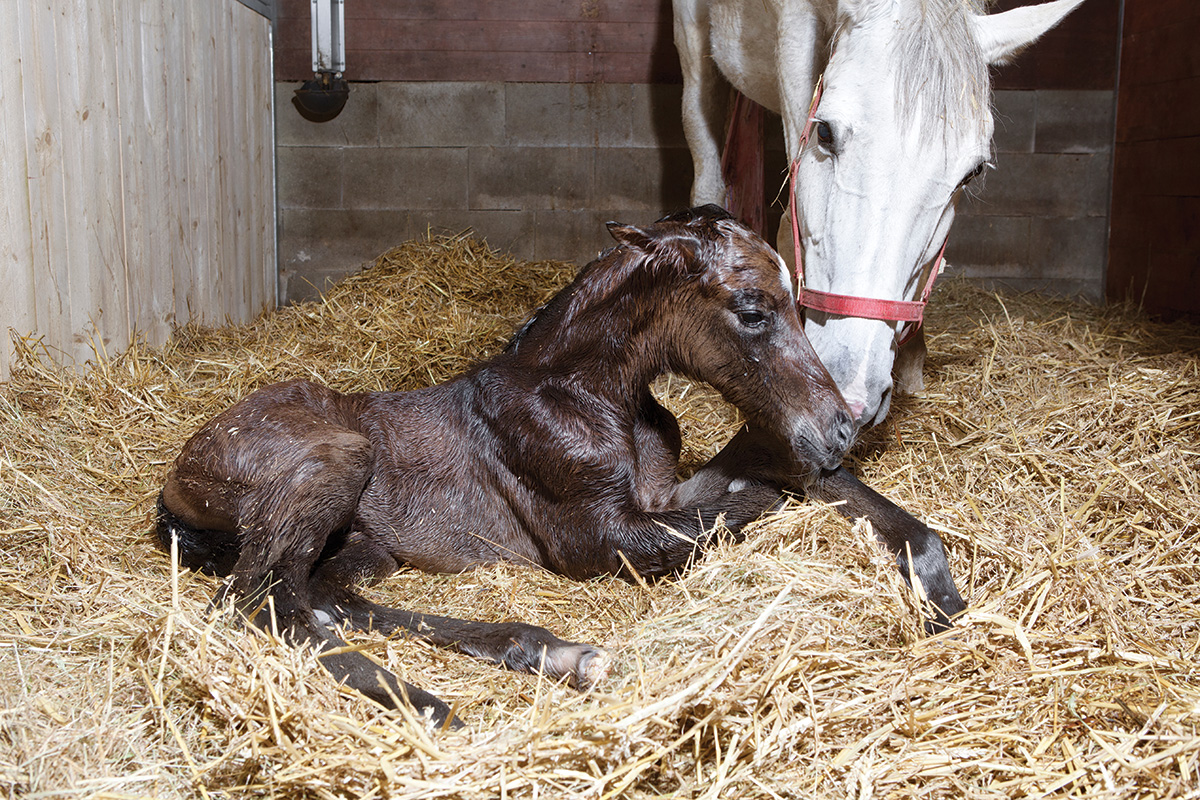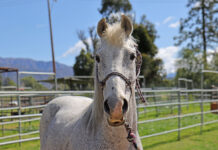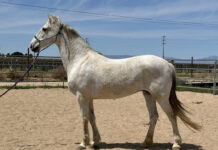In this edition of Vet Adventures, a neglected mare pulled from the kill pen has a long journey back to health.

“I know, I know,” said Maggie. “But we just couldn’t leave her there, Doc.”
Treatment Plan for a Neglected Mare
Maggie and I both knew that the kill pen industry was a bad business. The horses are crowded into filthy pens. They are generally sold to meat buyers, but the public can also purchase them (typically at a large markup). I completely understand wanting to help these horses, but buying from these places perpetuates a horrible industry.
Kill pen managers plant sad stories on social media (of course with an urgent deadline), lick their chops, and wait for the would-be rescuers to arrive with their checkbooks. Individual horse sales bring in far more than meat sales, and with a never-ending flow of horses to populate this market, kill lots laugh all the way to the bank. (Note to readers: Visit reputable horse adoption centers instead!)
But Della needed our help today. I’d managed to draw her blood the week before, and she was approximately 200 days pregnant. Normally I’d palpate and ultrasound the pregnant mare to make sure all was well with the pregnancy, but this simply wasn’t possible with Della.
Her belly wasn’t very big, but she was streaming milk from her udder and there was a discharge under her tail. These are common signs of an infection of the placenta, which can harm the fetus.
The neglected mare was surely unvaccinated, and I had to take my best guess as to what infectious agent could be causing the symptoms and come up with a treatment plan. Della would have to be on the medications until she foaled.
The mare stood at a safe distance as I placed a small tub of grain on the ground with some medicines carefully mixed in. I’d added a dollop of molasses for good measure.
Della pretended to ignore the tub, but after doing battle with herself for several minutes, the food won. She lowered her head to eat, never taking her eyes off me. She took a few suspicious bites, then devoured the mixture and licked the tub clean.
“This is what you’ll be doing twice a day,” I said to Maggie. “If the symptoms begin to improve, it’s a good sign that we’re on the right track.”
Maggie looked anxiously at Della, who was still licking the dish. “Can the baby be saved?”
I sighed. “Fifty-fifty. Horses tend to get wary of oral meds after a while, but even if we do everything right, we could still lose the foal.”
Maggie set her jaw, a look that I knew well, and I chuckled at the unsuspecting Della, who was going to be medicated twice a day no matter what. Over the next month and a half, Maggie used a rotating arsenal of applesauce, ground carrot, peppermint, and molasses to trick Della into eating her meds. Maggie was also halter-training the once neglected mare and getting her used to being handled.
Foaling Night
Della improved, but I was still concerned and wasn’t surprised to hear from Maggie late one night. She was very experienced with foaling mares, so when I heard the worry in her voice, I hurried to pull my boots on.
“Something’s wrong. Della’s been showing signs of labor all evening but she’s not progressing.”
Della was on her side breathing heavily when I arrived. Her vitals were stable, mucus membranes were a healthy pink, and her water hadn’t yet broken. There was no baby in the birth canal, although the cervix was dilated. As I gently pulled my gloved arm free, the mare strained vigorously and suddenly a red structure ballooned from the birth canal.
I gasped. “Red bag!”
Maggie looked at me in horror. “What on earth?”
There wasn’t time to explain. This was a true emergency. Because of the damage done by the infection in the mare’s uterus, the weakened placenta had separated from the uterus with the foal still inside. We had to get him out immediately or he would die.
I grabbed my knife from my belt and sliced open the thick red membrane, being careful not to cut the foal. Maggie and I each grabbed a front foot, and soon we had the foal on the ground. I cleared the mucus from the small nose and gave him a few rescue breaths while Maggie rubbed him vigorously with a towel.
His heart rate was too low, so I ran for the emergency kit as Maggie took over the rescue breathing. I injected a strong stimulant into his vein and continued toweling him off. When his chest finally began to rise and fall, Maggie and I high-fived each other.
I heard the mare get to her feet behind me. It occurred to me how vulnerable Maggie and I were, hunkered on the ground by the foal, but the mare simply reached her head between us and began to lick her baby. It’s amazing how they always seem to know when we’re helping their babies.
Will to Live
I monitored the foal’s heart rate and gave him a second dose of the stimulant. He was still very weak, and I knew that he was going to need a lot of care.
We had to milk the mare, tube-feed the colostrum into the baby, help him stand, and place an IV catheter. Poor Maggie had to feed him around the clock and get many medications into him. He was unable to nurse on his own for almost a week, and he had a crooked right front leg like his mama, but he lived.
Maggie was exhausted but happy the next time I saw her. And she was actively working on new legislation to close the kill pen businesses down for good. It would be an uphill battle, but if anyone could do it, it was Maggie.
This edition of Vet Adventures about a neglected mare appeared in the June 2022 issue of Horse Illustrated magazine. Click here to subscribe!





